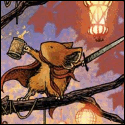|
Welcome to Let's Learn About the American Civil War.jpg) American Civil War, Brothers vs. Brothers is a total conversion mod for Empire: Total War which attempts to provide both an accurate and entertaining interpretation of the civil war battlefield. They are also currently developing a campaign mode that is still only partially finished. The most recent version is 3.6 Beta and while it is very promising, its primary feature is a CTD around turn 30. Unfortunately we won't be able to do much more than explore it briefly I am not any more than an amateur historian, but I love the civil war. With all the controversy over the Confederate flag and so many arguments being made with no basis in actual historical knowledge beyond their own wishful thinking, I thought it might be fun to educate people on the history behind it all (and hopefully be educated myself), and to use this mod as a model to show off different tactical and strategic situations. It would also be nice to get people interested both in this pivotal conflict and in the mod itself, which deserves all the love in the world. So instead of playing out a single campaign, this LP will feature episodic educational content and serve as a simulator of different tactics and battlefields of the war. I'll show you the evolution of fortifications and how that led to trench warfare, the changing role of artillery throughout the war, the common misconceptions about both sides in the conflict, and how the roles of infantry and cavalry evolved throughout the war, and how that was in some ways connected to the evolving social and political landscape. I will also be introducing you to the many men and women who drove these changes. I am going to do my best to assume someone is reading this with minimal foreknowledge of military history. That said if you need something clarified or wish to do the clarifying yourself, please bring it up. Some Background The American Civil War was fought between 1861 and 1865. It remains the bloodiest war ever fought on American (North or South) soil, resulting in over half a million US soldiers dead and irreparably crippled. It also established the United States as an industrial powerhouse, utterly changed the American economy, and set political precedents that are still being felt today. More than that, the American Civil War was in my humble opinion the most character driven conflict in history. It is a war whose causes are still debated today as part of a very real, very violent discussion on race in these united states. It is a war that ended slavery and more recently, has resulted in national marriage equality, yet also ushered in the dark age of Jim Crow and economic and educational segregation in the north. It was a war that took honorable gentlemen, brawling backroom politicians, impovershed farmboys and gutter rats from cities across the country and cast them into the great inferno. It was the first conflict in US history that saw massed, intentional recruitment and arming of nonwhite soldiers. It was the first major conflict to be captured by photograph. Hopefully I will be able to adequately introduce you to the people who drove and shaped this conflict, as well as those who were caught up in the madness. The Mod .jpg) I am not in any way associated with this mod. I found it entirely by accident and think it deserves to be shared. As you can see, it is absolutely gorgeous and playing it feels as real as any total war game can. My favorite thing in this mod is to just open a battle and let the two sides have at it. Currently updating to the latest beta is a bit convoluted, though not too bad. It is not especially stable and can take a while to boot. All that said, it only took me about half an hour to download everything and get it all running. This is the moddb page for the mod. It contains links to all the relevant instructions. If you run into any issues I will do my best to help. Here is the forum at Total War Center .jpg) Now this mod only really demonstrates things as well as the Total War Engine can, so I may end up dipping into some of my other civil war games to show or explain certain concepts. Obviously if you have anything you want to know please feel free to ask. Also if you note something I say that is wrong or may have a different viewpoint, please don't hesitate to point it out. I am hoping to educate and I know my point of view can be slanted. Rules for This LP While I will be using Brothers vs Brothers for most of this LP, I certainly welcome anyone who wants to show off a different game or engine, or even use this mod to show off something I haven't gotten to (though please clear that with me first, gmail should be in the profile. I'm not adverse to working together with someone on an update, just remember I tend to work slowly). I am absolutely comfortable with people adding their own content so long as it is in the spirit of the thread and based in historical fact. Also if you want to write historical fan fiction be my guest, as long as it's good. There are no spoilers so don't worry about that, hopefully at this point most of us know who won. That said, I have heard some interesting arguments to the contrary that I'll be going into. If anyone has insider stories and information about this mod that the developers would be cool with sharing, that would be wonderful. Unfortunately my computer isn't really up to taking video of this game, so it will have to stay screenshot. I will post links to other videos made if there's any interest or it fits with the LP, as well as links to relevant historic videos (such as live fire cannon demonstrations). If anyone would be interested in posting their own video please feel free, and I'd be happy to co-commentate. For now that's the best I can do. I would actually appreciate someone helping me out with a video because this mod deserves to be seen in action. Final note - I am currently working full time, newly married, and in a weekend college program. Updates will not be as regular as some would like. I apologize in advance for that. I also haven't worked on an LP since 2007 and that was a historical fanfiction that wasn't good. Please bear with any rookie errors and let me know so I can correct them. I got very little feedback in the sandcastle.
|
|
|
|

|
| # ? Apr 19, 2024 15:24 |
|
Reserving for something probably
|
|
|
|
So let's talk about civil war forts. The American Civil War is considered the first historical example of trench warfare, and saw histories first mass deployment of earthen fortifications, and the end of the age of brick and mortar forts. As a quick little study, let's look at Forts Sumter, Pulaski, and Wagner. Fort Sumter  Click here for the full 1920x791 image 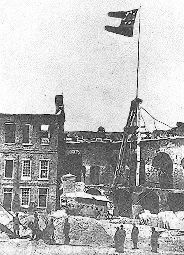 Construction on Fort Sumter began in 1829 and was only mostly finished at the start of hostilities. It was a massive brick structure built out on a peninsula, very difficult to attack. In the initial battle of the war the Rebels shelled it for over a day, with the only loss being one of their own to a misfiring gun. The Federals lost 2 men while they were firing a 100 gun salute after surrendering. A bloodless start to one of the bloodiest conflicts in American history. In 1863, the Union launched a combined naval/infantry campaign to close off Charleston harbour and take the city. During this, Fort Sumter's original shell was left largely in ruins by constant bombardment, while sand and earthworks replaced many outer sections of wall. With these modifications, the fort never actually fell to assault. and the Confederate soldiers not only held on but sank several Federal ships. Fort Pulaski 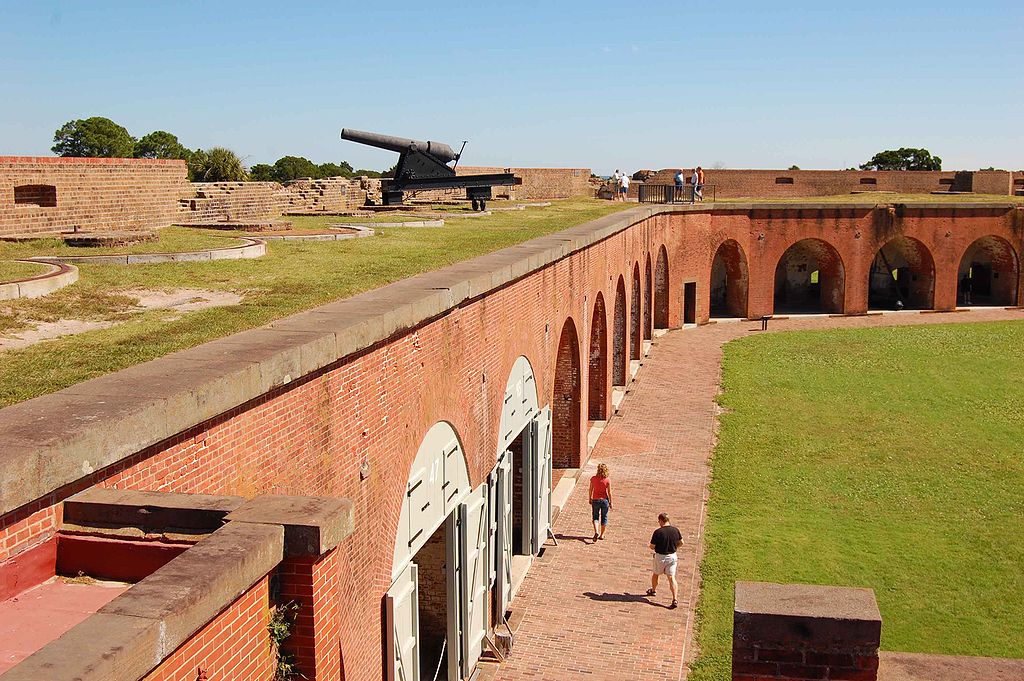 Fort Pulaski was built near Savannah, Georgia in 1833. In 1862 it was surrounded by a Northern army with 32 rifled artillery pieces and, when the Confederate commander refused the offer of surrender, they proceeded to reduce the fort's walls from as far away as 4 miles. This is considered to be the death of the age of brick forts, and a major step in the development of artillery. The extreme range from which Pulaski was reduced and the ease with which the Federal guns broke through its walls necessitated a move away from solid construction materials to more absorbent earthworks and trenches. 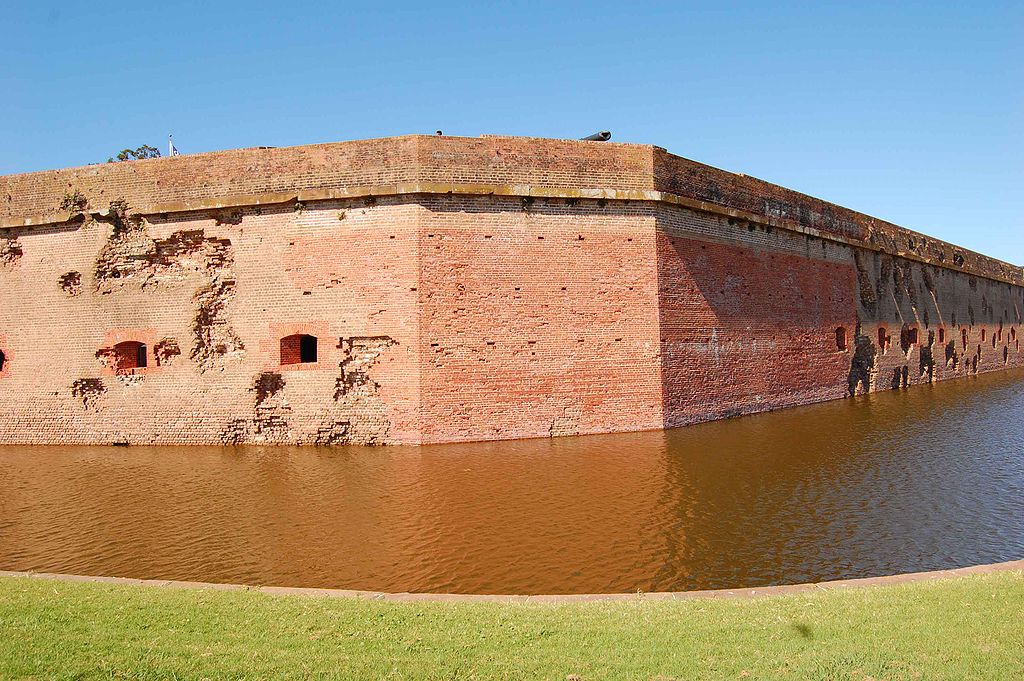 Here's a picture of some of the damage inflicted, after it was repaired. Battery Wagner 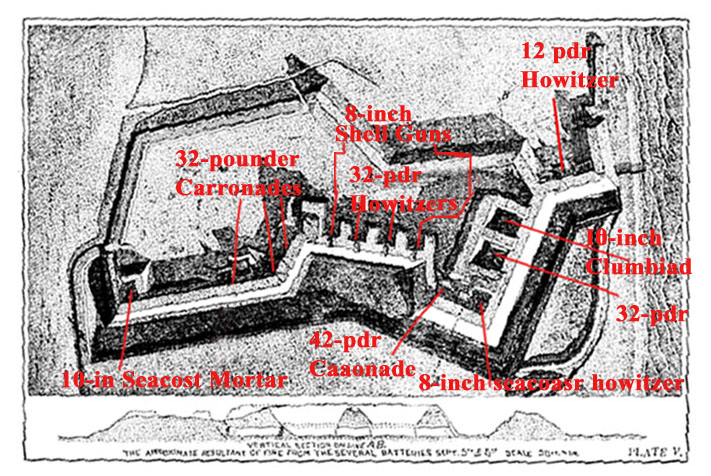 Finally, here's the star of the movie Glory: Battery Wagner. Wagner was part of the fortification systems around Charleston which included Fort Sumter, and was an example of an all earthen fort (or a very extensive entrenchment system). While Pulaski was picked apart by rifled cannon relatively quickly, Wagner endured 2 major assaults and over 60 days of bombardment before being abandoned due to lack of fresh water. Casualties for the defenders were relatively light, as they were able to shelter in massive bombproofs. The picture is an old diagram because the actual fortifications washed into the ocean after it was abandoned. The Update .jpg) So here is an example of assaulting a fort in the game. I made numbers relatively even to make up for the somewhat buggy AI when it comes to siege battles. As I develop an understanding of how the AI works expect me to get better at manipulating it. 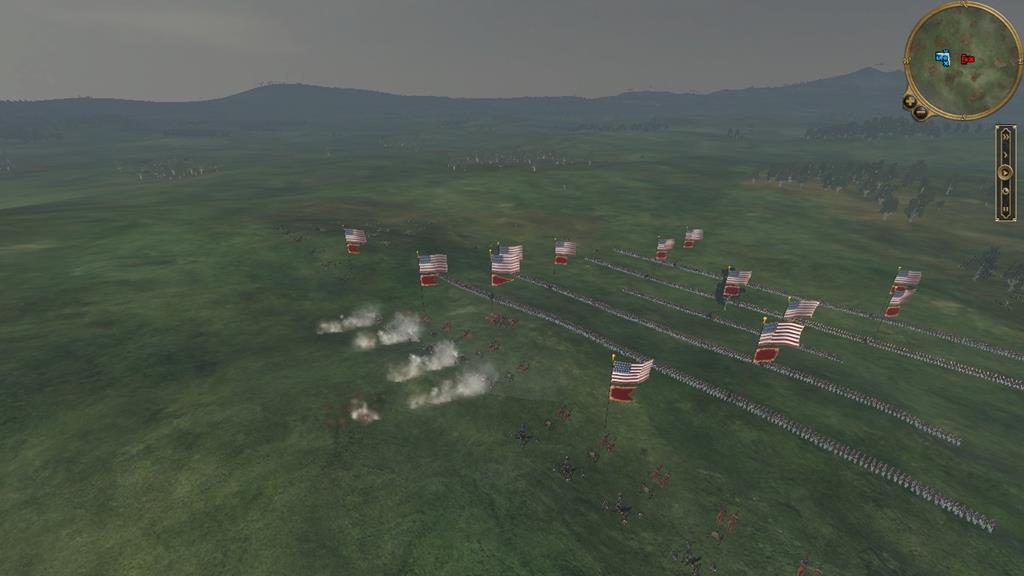 My deployment. As I understand it, standard tactics when attacking fortifications during the war was to to assault a narrow front with the bulk of the attacking force in reserve, ready to exploit any breach by the first wave. If anyone has seen the movie Glory, the assault on Fort Wagner was intended to play out like this. The 54th Mass (an all black regiment) was given the dubious honor of leading the assault and actually drove the Confederates to their front off the ramparts, into the fort itself before being driven back by concentrated artillery and reinforcements. Supporting white regiments also made it into the walls but were unable to carry them, and further reinforcements were delayed and uncoordinated. General Strong was killed, as well as Colonel Shaw (the white colonel of the 54th Mass). The 54th took by far the heaviest casualties, losing almost half their number in the assault. I would like to mention the movie Glory has a number of historical embellishments, though it remains a great movie. Chief among those to me is the portrayal of Brigadier General Strong as something of a coward and bully. Historically he offered Shaw the opportunity to lead the assault, and he was the one who pointed at the color bearer and asked who would carry the flag if that man fell (a duty for which Colonel Shaw volunteered). Both men were killed as a result of the assault, Strong from infection or blood loss after the battle and Shaw gunned down inside the works. In case you were wondering, there is a 54th Massachusetts in this mod. An interesting and quick account of the storming of battery Wagner can be found here Anyway, my plan was to lay down a covering fire with my leading regiments and heavy batteries while supporting units pushed right up to the walls. .jpg) .jpg) .jpg) Some glamour shots, just to show off the smoke effects and how much love was put into this mod. .jpg) Our target on top of a hill and flanked by cliffs, forcing me to either assault frontally or send units all the way around the map under mortar and cannon fire to hit the rear. I decided to concentrate my men and push in everything at the front. Tactics of the time called for wave attacks, which was the idea of my deployment. The reasoning behind this was that the first wave could establish a breakthrough which would then be reinforced and followed through by following units. They would also take the bulk of the fire and engage the defenders while the following waves moved up behind them. This strategy worked very well attacking forts in the Mexican War, but by the time the civil war weaponry advances came around things got ugly and this tactic was rarely successful. .jpg) One more beauty shot of the artillery. These are parrott rifled guns, invented in 1860. They had an unfortunate tendancy for the breach to burst when fired over time, and so were avoided if other options were available. Nonetheless, they were accurate at over a mile and came in heavy, siege variants such as the "swamp angel", a massive 300 pound Parrott that was utterly innefectual in its brief bombardment of Fort Sumter (later in the war). Note: Any time pound is in front of a gun name, it refers to the weight of shells it would fire. The barrel of a 10 lb parrott weighed in at nearly a ton. I'll be talking more about artillery in the next update. .jpg) Here's the in game model of the 30 lb parrott, a heavy siege gun. These saw heavy use besieging Richmond and Petersburgh .jpg) General Irvin McDowel watches the battle. Throwing this in to show that they included specific generals with specific models. We'll hopefully be seeing all of them in time. .jpg) Here is Joe Johnston. We'll be going into their service records later. On to the attack .jpg) The confederate fortifications. Unfortunately, the AI still isn't completely competent at siege battles yet, so they spent a lot of time moving troops around instead of firing. I think it's a line of sight issue, as LOS still seems a little broken on the corners. It's not terrible but is noticeable from time to time. Hopefully this will be improved on as the mod is updated .jpg) Our leading Maine regiment (the other leading regiment was from New York). This is the color guard, considered the heart and soul of the regiment. Historically, the state flag would have been held next to it as even in the north state pride was far stronger back then. Writers and speakers still referred to the country as "these united states", rather than the United States. A small but important distinction. .jpg) .jpg) New York takes aim and fires, and the fight is on. Now in Vanilla Empire casualties would be ridiculously heavy at this point, with the artillery and constant barrage of minie balls. This mod actually changes several aspects of gameplay to make it more in line with historical rates of fire, accuracy, and casualty rates (as well as morale, which I'll get to soon). In my opinion, this makes for a more interesting and strategic experience, if more long range. .jpg) View from the Confederate works. My two lead regiments are in line and firing, while a reserve is extending our left. Two reserve regiments are still moving forward with the intention of scaling the walls. Though the mod is still using grappling hooks from Empire, historically it would have been more likely to see ladders or, in the case of earth fortifications, to just scale them. .jpg) Same view from the bottom of the hill. What it doesn't show is that I have 4 more regiments on the right moving up as well. .jpg) Here's a shot of Confederate Zouaves. Confederate (and much less often Union) regiments were often outfitted by a wealthy landowner, who would assume a leadership role whether qualified or not. Sometimes they would tend towards more flambouyant designs. In the case of the Zouaves, I believe they were patterned after the french army, with either a blue or gray color base. On that note it was not uncommon, early in the war, to see Federal units in gray uniforms and Confederate units in blue, depending on what was available when they were outfitted. There's actually a cool story behind why gray was such an important color in the pre-war army, but I'll get into it a bit later. .jpg) They are attempting to sally with a Maryland regiment. This is an example of the AI quirkiness defending forts in this mod. It's not bad, it's just that if they had waited until my first assault was repulsed this would have far more impact, and be more in line with historic doctrine. Maryland was considered a border state during the war, a state that remained with the Union though slavery was legal. Because of this dichotomy it gave a significant number of men (I believe around 20,000 throughout the war) to the south. It also gave several times that to the north. .jpg) Or they noticed my Maine regiment breaking and falling back. drat! Morale works much differently in this mod than in vanilla Empire, and more in line with historic accounts of regiments falling back and reforming. A "broken" regiment will retreat until out of immediate danger, then reform ranks and be available for another advance. It's not as though nothing at all happened and they're fresh as daisies, as they will be tired and therefor more likely to break again if pushed right in, but it's a significant improvement from Empire where units would stand until they ran off for good. It makes for a more dynamic, interesting battlefield and forces me to play more conservatively, keeping back reserves to plug these holes. In this case, I've already committed my reserve on extending the right flank. The rest are advancing on the right. In my defense, I haven't played 3.6 much at this point. .jpg) Our left flank. We are still looking pretty good but that is a strong position. It's going to be a murder match to take those walls. .jpg) Just to show that New York is still representing. .jpg) Here's a weird bit of Beta buginess. They should be in a firing line. I know it's just a representation but it annoys the poo poo out of me. Maryland has been caught by our flanking manuever before they could try to turn our right, and is now under fire from multiple directions. We drive them back with moderate loss. .jpg) Maine regains its nerve and pushes back up the hill, but they've taken close to 50% losses. It was to be expected as they were one of the front line units, but still quite a blow to them. This is actually in lines with historical casualty rates when assaulting heavily fortified positions in first wave units. There were other battles, Picket's Charge for example, where the entire attacking force took upwards of 50% losses. .jpg) In spite of the game paused icon, I love this shot. The modders just put so much love into the models and animations. I'm not even playing on particularly high settings. .jpg) Now that Maryland has been driven back, I've committed our reserves to gaining the walls. Love the midwestern hats even if they're on a NY regiment. Remarkably, there are something like 40 different infantry units per side in this game, and each has a unique model. I'm not familiar with the 18th NY, but judging from the outfitting I would guess they were militia? Someone care to correct me on that? .jpg) .jpg) They sally again, this time with a bayonet charge. It is driven back into the fort with heavy losses. .jpg) View from the artillery. Keep in mind that minus the enormous flags and UI, this is what a general would have seen. The only difference is that dozens of wounded (or men trying to fake wounds) would be limping back over the field to wherever the field hospital would be set up. A popular sentiment of the time was that any battle viewed from the rear looks like defeat. I'm showing this view because I hear a lot of armchair generals talking about what should have been done, and when I'm playing these games I often just zoom down to almost first person view just to remind myself that this is all they could have seen, and all they had immediate control over. They couldn't float over the battlefield and see their enemy's movements, point out exactly where to attack and how to move this unit and that unit. That they had any control at all speaks to the skill of some of those men at leading and fighting. .jpg) One of our assaulting regiments is driven back, while the 18th actually makes it to the wall. .jpg) The Charleston Zouaves come down and face them at the foot of the works. I have to say, watching this play out was pretty neat. The Zouaves wound up beating us back, then were pushed around to one side of the fort before they could get back in (their AI didn't realize it should get back in the fort, though it did form a firing line in an unflankable position). .jpg) Several more regiments come out through the gates, resulting in a wild melee in front of the works themselves. .jpg) They succeed in turning our right flank briefly, driving back several regiments. They have also committed their entire remaining force to this counterattack, and our reserve on our left has reformed from its earlier repulse. .jpg) We close in on their surging counterattack .jpg) and meet it with ragged volleys. It's a close in firefight now, but we have the advantage in numbers and they no longer have the protection of the fortifications. Once our right flank reforms, we'll also have them in an enfilade (flanking fire). .jpg) The counterattack is scattered and driven back, herded away from the fort. .jpg) Joe Johnston and his staff emerge to rally the defenders, right into the teeth of a charging Pennsylvania regiment. If my descriptions don't seem as concerned with strategy, that's because at this point I had committed and the action was just devolving into a series of uncoordinated firefights raging across the hillside. In that sense, again, it was historically accurate. Once a battle started generals rarely had much control over engaged units. After a melee in which the regiment in the background is driven back as well, Joe Johnston is killed by a bayonet. .jpg) Leaderless, only two units remain to defend the fort and its mortar batteries. One, the Charleston Zouaves, is outside the walls and falling back, but laying down a withering flanking fire on us. The other is still defending the ramparts and firing its napoleons at our assaulting columns. .jpg) .jpg) .jpg) They succeed in driving back a couple regiments with their determined defense. Numbers tell, however, and during a lull they climb out of the fort and launch a final bayonet charge. 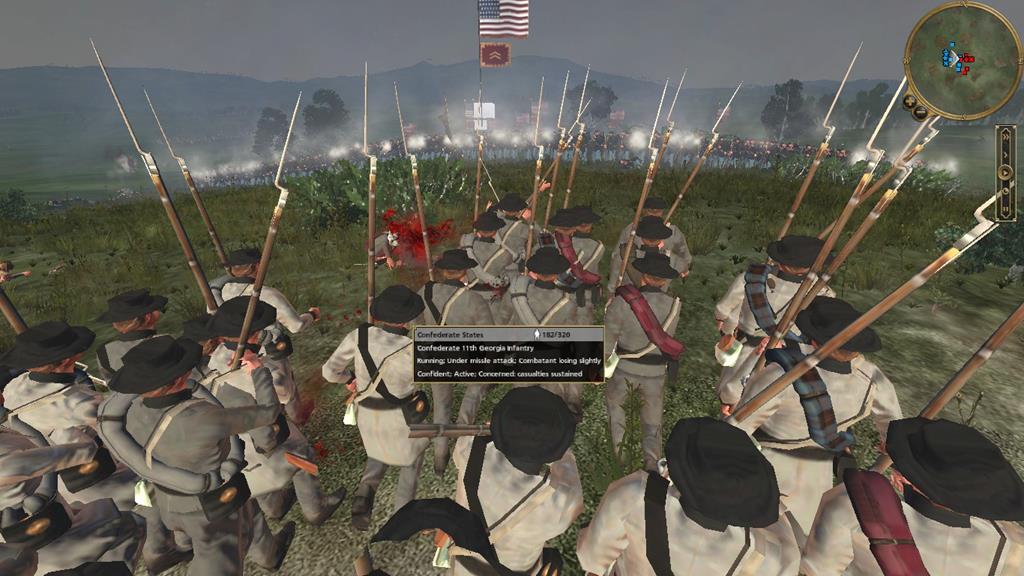 .jpg) .jpg) They are ultimately driven off with extremely heavy losses, and after mopping up the mortars within (and, for some reason, behind) the fort we declare victory. 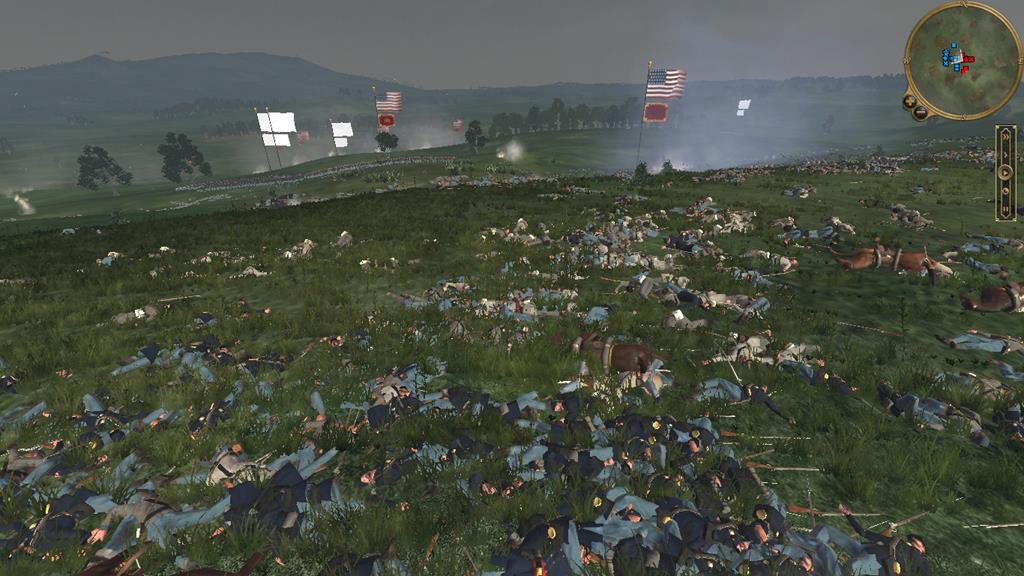 Just a view of the absolute carnage before the walls of the fort. This brings to mind some of the photography of the war I've seen. The Civil War was actually the first major war to be photographed, and I think a lot of people were hoping that by bringing actual images of the carnage to people, they could ensure it was the last war. As we've seen, they were wrong. Even with digital HD video we still go to war over bullshit. here is the library of Congress's collection of Civil War photography, for your browsing pleasure. So I'll leave you with some thoughts about the mod itself. I think my favorite thing about this mod is the revamped damage and morale system. Units don't just sit in place taking extreme casualties until it's time to run off the map, they fire, fall back under extreme stress, then surge forward again. It makes them feel much more human as well as creating a more fluid, dynamic flow of battle. Ultimately much more interesting and fun. Hopefully you've enjoyed this showcase. Next update I would like to do some artillery demonstrations and tell you about the battle of Malvern Hill Again, if you have any comments, questions, criticisms, or further information I would very much appreciate the feedback.
|
|
|
|
McFetusBurger posted:It is a war that ended slavery and more recently, has resulted in national marriage equality, lol what?
|
|
|
|
14th ammendment It was added to the constitution in 1868 to address citizenship issues with former slaves after the war. Passage of the ammendment was one of the requirements for regaining statehood in the south. It guaranteed citizenship rights and equal protection to all people under the jurisdiction of the United States. While this was specifically aimed toward former slaves, it was central to cases such as Roe v Wade, Brown v board of education, and Obergefel v Hodges, the recent marriage equality case. Like I said, effects of the Civil War are still central to US politics today. Cuveball Sliders fucked around with this message at 13:52 on Jul 12, 2015 |
|
|
|
How good is this mod at simulating naval combat of the era?
|
|
|
|
Unfortunately it doesn't do that yet, they only just implemented siege combat. If it's still not in when I get to the navy I will probably use Shogun 2 to at least show off ironclads and steam frigates.
|
|
|
|
Do the officers carry revolvers now, or are they still wielding flintlock pistols?
|
|
|
|
That's a good question. I'm pretty sure the model was updated to carry a revolver, but would have to double check next time I run a scenario. On that note, I have an update just about finished so it should be up tomorrow. After that I would like to start doing more as Confederate. Would you be interested in learning about JEB Stuart's Cavalry, Stonewall Jackson, or partisans (such as Mosby's raiders)? Eventually we'll be doing all three of these so I'm just trying to get a feel for what everyone is interested in seeing. If you'd rather see something else then let me know and we will get to it. Cuveball Sliders fucked around with this message at 04:11 on Jul 13, 2015 |
|
|
|
I'd say Stonewall Jackson. He definitely was an eccentric character that I don't think a lot of goons who aren't familiar with the American Civil War know too much about. Looking forward to the partisans though, especially if you get into the bushwhackers and Bloody Bill Anderson. Some real Heart of Darkness stuff there that I think gets lost when people reflect on the Civil War.
|
|
|
|
I'd say either stonewall or the Partisans
|
|
|
|
So if updates feel a little disjointed and all over the place right now, that's because I'm trying to give an introduction on the methods and styles of warfare and the branches of armed forces of the time before we get into the chronology of the war. With that said, this update's battle was actually not as exciting as I'd hoped it would be so I like to think I made up for it with a lot of background. We'll be getting back to the volley line next update with the Stonewall Brigade. This update is about one of my favorite subjects: Cannons By 1860, technology had advanced beyond a lot of generals' understanding of how to use it and, more importantly, how to counter it. While a great deal is made of the invention of the rifled musket extending a units effective range to over 200 yards, rifled artillery was able to effectively hit targets over 2 miles away (or if firing at a sufficiently large target, 4 to 5 miles). The effective range of warfare had been effectively tripled and antiquated massed infantry tactics were slow to catch up. Added to this were significant advances in the ammunition fired. Long range fragmentation shells were not a new technology, having existed since the Napoleonic Wars. By the American Civil War, like so many other technologies of the day, they had been refined to about the limit of what could be done with that specific delivery device. Technique and training had also developed greatly, and well trained crews could supposedly hit a man sized target at a mile within a couple shots. 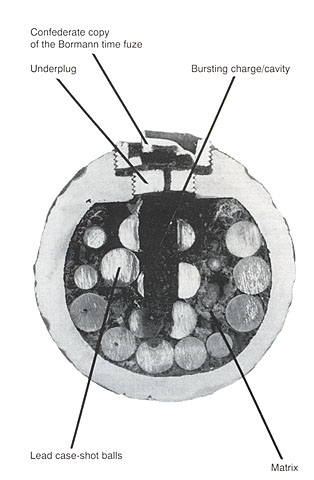 A diagram of the interior of a Confederate case shot. When the shell was fired, it lit the fuse which then burned to a pre-cut length and blew apart, spraying pieces of itself and the lead balls inside at deadly velocity. I believe the matrix was to hold the balls in place to prevent them from shifting around and potentially knocking the shell off course. 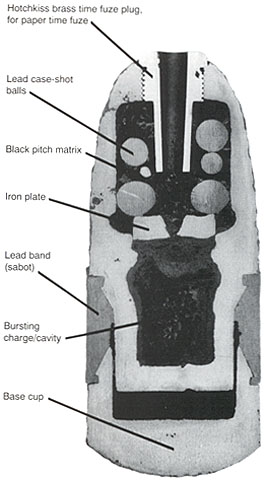 A Federal Hotchkiss shell. Designed to be fired from a three inch ordnance rifle, it was more aerodynamic and the positioning of the burst chamber in the back projected the iron balls forward with much greater force. 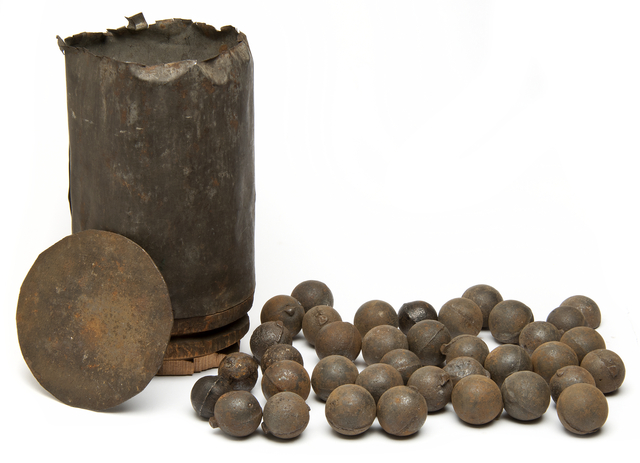 Cannister, or grape shot, was used as a close in anti-infantry projectile. It was a can filled with about 20-40 lead balls, which skilled crews could fire into the ground to send the balls spinning out, greatly widening the area of effect. In Brothers vs Brothers you can actually see a spray of dirt kicked up in front of guns when they fire cannister. When the enemy got very close (within a hundred yards) artillery crews would load two cannisters into a single charge. These cans turned artillery into 2 ton shotguns and could singlehandedly turn back a surging charge. We'll be seeing a bunch of that in this update. Good source of information on artillery types and battery makeup during the war. Also the source for the above diagrams of shells Cannons were powerful not just in killing and causing havoc, but the randomness of the fragmentation of a shell's detonation was a powerful morale killer. Veteran regiments were known to go to ground when they heard a rifled piece firing, rising when it burst to try to catch it before the crew could reload. Fairly quickly into the war it became apparent that attacking entrenched artillery head on was an exercise in futility. In fact, that became apparent to Robert E. Lee at the battle of Malvern Hill. 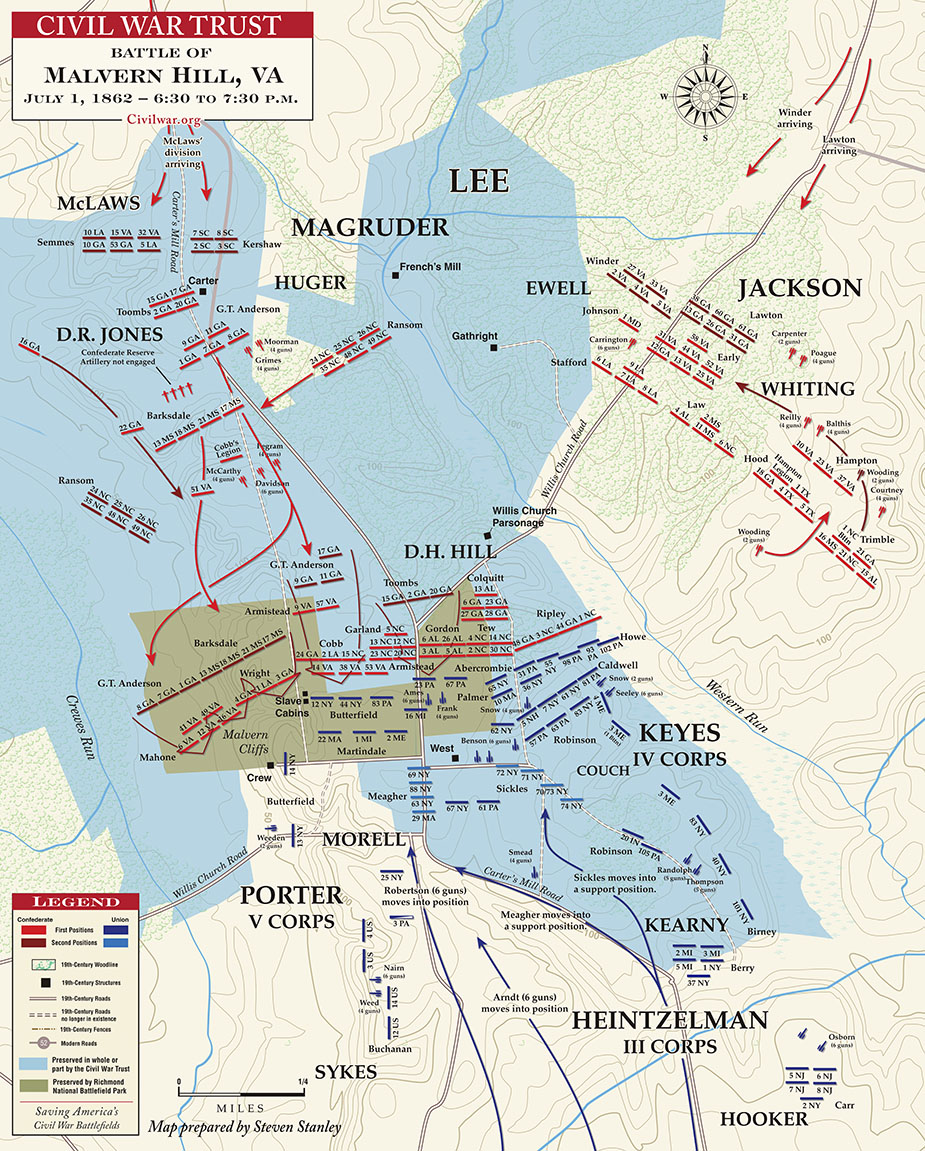 The historical situation at Malvern Hill. source Malvern Hill was fought in 1862, and closed out the seven days campaign with a meaningless tactical victory for the Union as they were retreating back to Washington. The 7 days was Robert E. Lee's first major campaign as commander of a Confederate Army, replacing the injured Joseph Johnston to lead what would become the brilliant Army of Northern Virginia. For the north, it closed out the frustrating peninsula campaign in 1862 which saw them at the gates of Richmond with a hundred thousand men before being driven off by the boldness of Lee's aggression and the timidity of their own commander, General George Brinton McClellan. Malvern Hill was Lee's attempt to hurt the Federals before they withdrew out of his reach, as he believed an attempt to pin them the prior day had been lost. He ordered 3 divisions, McGruder, Jackson, and DH Hill forward into an entrenched Union position. So let's begin with this demonstration of the power of artillery .jpg) I chose a map that gave a height and terrain advantage to the defender, to simulate some of what the Confederate army had to advance through. You'll have to excuse that it's on a South American based map, as that was the most accurate terrain to what I wanted. I positioned the guns to take advantage of a natural funnel that the confederates would basically be forced to attack through to reach us, a low depression that's barely visible which my guns are in a crescent around. The Union side has no infantry support, to reflect the very limited role they played in the engagement. To simulate the failure of Lee's artillery to assemble and bombard the federals as ordered, I have given the confederates division level numbers, or about 3,300 men, with no cannon. In the actual battle what Confederate artillery was on the field was not a factor. Though there were nearly 18,000 Federal infantry soldiers on the field, very few of them saw action that day. This is because of the effectiveness of the dug in artillery in stopping even a very determined charge. It is also due to the forgotten genius who may well be the greatest American artillerist who ever lived, General Henry Jackson Hunt. 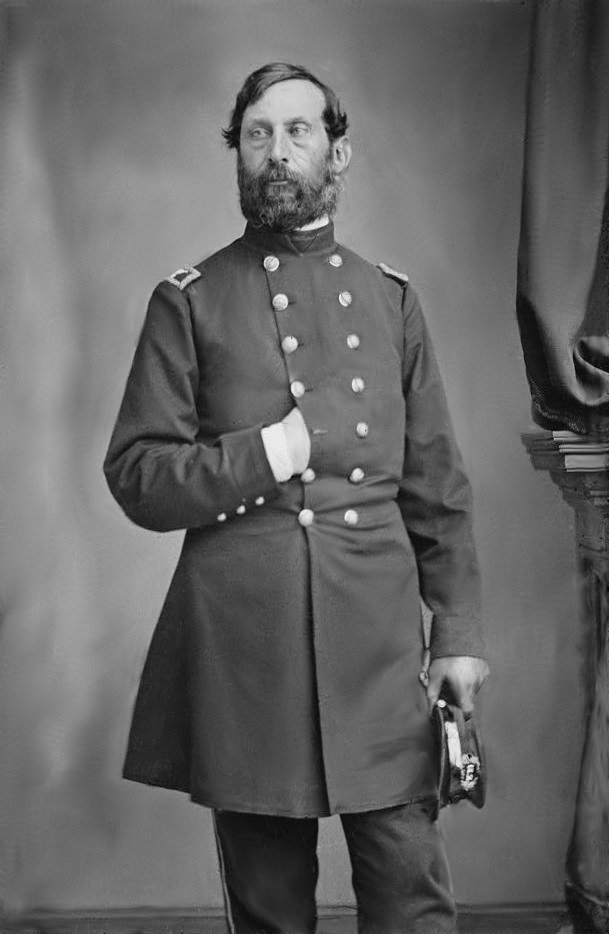 General Hunt was a lifelong soldier from a family of soldiers and politicians (his uncle and namesake was the second mayor of Detroit). Right before the war, then Major Hunt was a major part of the revision of artillery tactics and drills and co-authored the Instructions for Field Artillery. He commanded a single four gun battery at Manassas and singlehandedly covered a bridge for retreating Union forces. His brilliant use of artillery in the Peninsula campaign and especially at Malvern Hill led McClellan to name him Chief of Artillery for the Army of the Potomac just before Antietam. Prior to the reorganization of Federal armies artillery was generally attached to their army divisions and corps. Hunt advocated the operation of artillery as a separate branch of the armed forces, operating in massed batteries of 100 or more guns, and was instrumental in the creation of the artillery reserve of the Army of the Potomac. We'll be seeing more of him as we explore the war. .jpg) General Robert E. Lee's unique in game model. This is at low settings because I'm trying to avoid crashes, but I think it still looks great. I don't want to get on a major tangent and I think Lee deserves his own update where I can adequately show just what a remarkable and yet flawed general he was, so for now we'll be moving on. Still a great shot though. .jpg) General George B. McClellan. Again he deserves his own update. For now just know he is the reason the Army of the Potomac was one of the best fighting units in history, and also the reason it was one of the poorest led. I also like that his custom model is the same as the default staff model. He actually did look like that. .jpg) Again, just love that commander's eye view. .jpg) So, somewhat annoyingly, the AI really wants to make a nice neat line when it attacks. I actually held fire because it was taking so long and I didn't want to destroy their morale before they even began moving. As frustrating as it is though, it is also historically valid. It could take divisions an hour or more to go from marching columns to a line of battle and begin moving into an assault. This was one of many reasons coordination could be so difficult during the war. My holding fire was also historically accurate. General Hunt despised crews that fired too fast, saying they lacked the stomach to stay on the line and were trying to fire off their shells so they could move back to the limber wagons (wagons filled with artillery ammunition). He taught his crews to fire slowly, check their aim and trajectories, and make every round count. He was known to tell his men not to waste their shells, as each shot cost taxpayers $2.67. .jpg) They finally begin moving forward, and I resume firing. .jpg) .jpg) .jpg) Some screencaps to show the shellburst and shrapnel effects. Also Lee leading his men. In spite of his high rank, General Lee spent a lot of time near the fights he commanded. His men noticed this and by Second Manassas were practically worshipful of him, though that was for other reasons as well. Just to clarify, Lee was not directly on the field at Malvern Hill. It was actually Daniel Harvey Hill and Thomas "Stonewall" Jackson's assault. .jpg) I was lucky enough to capture a shell burst directly in front of the line. These were especially deadly as the shrapnel would fly out in basically a circle, cutting down anyone nearby. You can see a spray of red on screen. .jpg) The first regiment in line has already turned and is falling back. Here you can see the wave assault system in action, where the first unit draws fire and allows the second and third waves to get closer, successively. Bloody and, at this point in history, not that effective. .jpg) Our first cannister shots strike home. If you look closely at the red spatter, you can see just how much of a cone even smaller caliber rifled pieces could get out of a single burst. There were reports at Picketts charge of entire companies falling down in the face of a single charge of cannister. Malvern Hill was one of the first and few battles where it saw significant use. .jpg) Second wave just couldn't stand up to that. If you look at the numbers remaining, that's nearly half their regiment down from cannon alone. .jpg) The first assault has basically been destroyed. You can see a second brigade forming behind them and starting forward. For whatever reason, the AI was perfect and behaved exactly like its historical counterparts in this battle. Lee's original plan called for a massed assault by three divisions to strike at once. What happened was one division (McGruder) never even made it into the fight. The other two were uncoordinated, attacking piecemeal and getting shredded one by one. .jpg) Gratuitous cannon firing shot. While this mod (and the total war engine) has a single type of artillery per battery, historically they were often mixes of different rifled pieces and, early on, would include 2 howitzers. However smoothbore guns such as the Napoleon would be seperated from rifled due to different effective ranges. .jpg) The Napoleon was a smoothbore gun that fired a 12 pound shell. Because they weren't rifled they were innacurate at ranges over a mile but were excellent for short range, anti-infantry work because of their larger munitions and bores, creating a bigger scattering effected for cannister. Unintuitively, the Napoleon was named after Emperor Napoleon III, not Bonaparte. It was named so because he provided funding for its design. .jpg) .jpg) The second brigade rallies and comes into rifle range, opening fire on our lower batteries. You may be wondering why they're not charging in. Because cannister charges were so heavy and scattered over distance, they tended to have a lower effective range than a volley of small arms fire. If these men charged the guns now, they'd get cut down mercilessly just like the last charge. By firing on us, they can take out some of the gunners and force them to abandon guns in order to keep the rest fully crewed. This means they will face less cannister fire when they (or the regiments behind them) do eventually charge forward. Also if you look at that regiment you can see it has no flag. Its color guard must have been wiped out by the barrage. I would love to see it modded in that nearby sprites pick up the colors when they fall, but I have no idea if that's possible in the Total War engine. .jpg) A South Carolina regiment swings into a firing line. The flags in this game are absolutely beautiful. I would love to see the mod include state flags as well at some point, but again not sure if that's even possible. Well let's talk about the Confederate flag. The flag that until recently flew over the state capitol in South Carolina... You know what, let's do this later. .jpg) See that gap in the line there? There's a visceral example of the damage a well placed shell burst can do to a person. .jpg) This is everything they have left. At some point I'm assuming Lee left the field because I never got a "enemy general has been killed" notification. .jpg) They're changing tactics. Instead of closing to firing range and trying to bring down the gunners they're going to attempt to rush the pieces in three waves. Again, hoping that the first two will bear the brunt of the fire so the third and strongest can hit home and at least clear out the bottom of the hill. .jpg) Here's the first rank getting torn apart by double cannister. This mod seems to follow a formula for cannister where it increases in effectiveness with proximity to the gun firing it. .jpg) .jpg) The second and third waves, from the point of view of our gunners. Imagine you have a giant shotgun that takes upwards of a minute to reload, you've been firing all day and just emptied it into the faces of recklessly courageous men, and now that's coming at you. Welcome to being a Civil War artillerist. .jpg) .jpg) They get the shot off and mow down basically the regiment's right flank. This shot effectively ends the battle. .jpg) The remnant of the Confederate assault. Historically the determined Confederates actually did manage to reach a small section of Union earthworks in spite of the slaughter they experienced and lack of leadership. They were repulsed with heavy losses. Malvern Hill was an incredibly lopsided engagement, with the Confederate forces taking some 6-8000 casualties while Union forces suffered barely 3,000. By some on field estimates, more than half of the confederate losses were due to artillery. Daniel Harvey Hill, commanding one of the most involved divisions in the attack, said "it was not war, it was murder." So now you've seen the cost of attacking entrenched Civil War era guns head on. Why didn't they dominate every battlefield they were on? After Malvern Hill, Lee was scrupulous about not attacking heavily fortified artillery. Pickett's charge was only launched after he believed the Federal guns had been withdrawn or destroyed, a brilliant bit of subterfuge by General Hunt who ordered his guns to cease fire one battery at a time in order to draw the infantry out. Otherwise it was rare for artillery to be put in the position Hunt found himself in at Malvern Hill, with commanding fields of fire and an enemy coming straight at them. It was far more common for them to be placed behind the main lines in long range support roles, or to "prepare" an area for attack. They were also very slow and vulnerable to capture by flank or rear attack. Because of this, artillery was usually used defensively or in support roles. Alright, so let's talk flags. The flag that so recently flew over the state capitol in South Carolina was not the Confederate flag. It was a Confederate flag, but the design for the national Confederate colors went through a number of iterations. .svg.png) This was known as the Stars and Bars. It was the first design of the flag, and patterned after the Prussian flag. It was chosen because, surprisingly, there was a lot of public support for adopting a flag that still resembled that of the United States. This flag satisfied those desires but caused confusion in battle, especially on the southern side where regiments might be in either blue or gray depending on availability. This flag was carried by the Army of Northern Virginia until the end of the war. 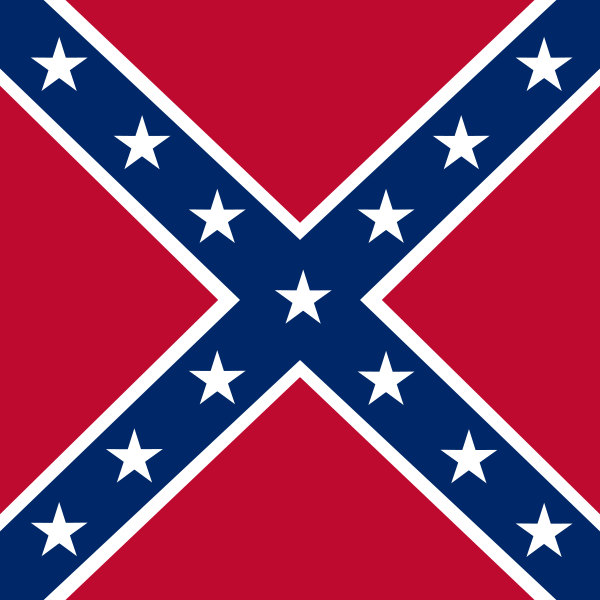 After the confusion caused by Confederate units carrying the stars and bars, this flag was created for the armies to carry in December 1861. It was designed by William Porcher Miles, a staff officer in the Confederacy, and based on a Carolina secessionist flag that used a flat St. George's cross. He recieved feedback that the cross looked too much like a catholic religious symbol and rotated it diagonally to look like a St. Andrew's cross, in order to satisfy jewish and protestant southerners.  resize.png) To solve these problems William T Thomspson, a Georgian newspaper editor, designed this "stainless banner". It featured a diagonal St. Andrew's Cross on a large field of white, a national embracing of the southern battle flag. Of the white field, Thompson said "As a people we are fighting maintain the Heaven-ordained supremacy of the white man over the inferior or colored race; a white flag would thus be emblematical of our cause". The chief complaint of the banner was that it looked like a flag of truce when used on the battlefield, and that ironically enough the large white field was easily stained. Because some controversial quotes were in that last paragraph, here is a source. .svg.png) This was the 1865 version of the flag, designed to solve the issues of the unstained banner. It was given the nickname the blood stained banner, an obvious reference to the red stripe at the end but also in my opinion reflected some of the ennui of the times, as the situation had grown bleak by 1865. Next time we'll take a look at the story of the Stonewall Brigade and the legend of its commander, Thomas Jonathon Jackson. Edit: Edited flag information, fixed oversized image. Cuveball Sliders fucked around with this message at 12:12 on Jul 14, 2015 |
|
|
|
This page is getting pretty update intensive, so in the interest of getting to the next page so I don't break somebody's browser I would like to hold our first thread contest. Historical Joke Thread Contest The rules are simple. Tell a joke, pun, or tall tale with a focus on history. Once we reach the next page the contest is over (and if somebody posts on the next page before I call it I will of course count them). The funniest or most clever post will be declared, and the winner will receive something nice. Right now I'm thinking a gifted steam game out of the 5$ or less bin. Also please bold your jokes so I don't accidentally miss one. I'll start: If at first you don't secede, try try again. ABC's doing a new sitcom about the Habsburg dynasty. It's called All in the Family
|
|
|
|
quote:After Malvern Hill, Lee was scrupulous about not attacking heavily fortified artillery. Pickett's charge was only launched after he believed the Federal guns had been withdrawn or destroyed, a brilliant bit of subterfuge by General Hunt who ordered his guns to cease fire one battery at a time in order to draw the infantry out. Lee also wasn't in a position to have to attack well positioned Union guns. It was commonly the Army of the Potomac which had to fight at locations of his choosing. The Union guns also stopped firing at Gettysburg because they were running low on ammunition. Artillery was also important offensively of course too. One of the many reasons for Lee's retreat following Antiteam was due to the number of cannons the ANV lost during Antiteam. DH Hill is interesting. He was a talented general, but butt heads with both Lee and Bragg. He was among the generals who revolted against Bragg after he failed to take advantage of the victory at Chickamaugua. He was one of the few talented generals that were actually sent west by Lee.
|
|
|
|
Wait, I'm confused. Isn't the St. Andrew's Cross always diagonal? It's pretty much a standard Saltire and Christian as all hell. Supposedly St. Andrew was executed on an X-shaped crucifix. Where on earth are you getting your "the symbol of a particular religion not be made the symbol of the nation" quote from anyway? Because putting the Cross of St. Andrew (and that's undeniably what it is) on the battle flag seems like a pretty clear nod both to the Souths' self-image as a Christian nation and their predominant Scots-Irish heritage.
|
|
|
|
Thanks for the correction, I should have been more clear and actually read the article all the way through. In my defense I was in class when I wrote that part of the update. The battle flag was based on a Carolina secession flag which had a horizontal and vertical stripes, a blue St George's cross. It was designed by William Porcher Miles, an officer in the Southern Army. Among the feedback he received was from a jewish man who gave the quote about the symbol of religion not being the symbol of the nation. Miles changed it to a St. Andrew's cross in order to satisfy the jewish and protestant populations that thought the St George's cross looked catholic. So the maker wasn't against any religious symbol, just the catholic one. I'm going to correct that now Syzpid posted:Lee also wasn't in a position to have to attack well positioned Union guns. It was commonly the Army of the Potomac which had to fight at locations of his choosing. I think Lee gets more credit than he deserves for picking ground. He was a genius when it came to understanding his opponent and how they would react, and therefor how to play them once the ground was chosen. Other than 2nd Manassas and maybe the Wilderness I can't think of many battles where the Army of Northern Virginia was able to choose the ground it fought on. They were surprised at Fredricksburg and only able to entrench because Burside's pontoon boats had been left behind. They were also surprised at Chancellorsville and only able to turn it into a major victory because of Hooker's hesitation. The 7 days was just an absolute mess strategically. quote:The Union guns also stopped firing at Gettysburg because they were running low on ammunition. As I understood the story, Hancock wanted the guns at Gettysburg to keep firing in order to keep his men's morale up. Hunt wanted to conserve ammunition for the approaching infantry assault and ordered his guns to fall silent one battery at a time in order to give the illusion that they were being destroyed and driven off by Porter's bombardment. Because the Confederates were also running out of ammunition to support the advance this triggered Longstreet to send the charge forward. quote:Artillery was also important offensively of course too. One of the many reasons for Lee's retreat following Antiteam was due to the number of cannons the ANV lost during Antiteam. True. I hope I didn't give the impression that artillery wasn't important offensively. When we get to Antietam I'd like to try to show how effectively it was used to drive Confederates out of the bloody lane, among other things. What I was trying to get at was in spite of its potential to dominate a battlefield it was rarely as decisive as it was at Malvern Hill due to most generals (and privates) no longer being willing to attack guns head on. Malvern Hill was special for a lot of reasons, it was basically a gunners wet dream. No counter-battery fire, infantry lined up and climbing an open field, and perfect defensive ground. Fredricksburg was an exception to the don't attack entrenched guns rule and frankly I don't know why, that charge never should have gone forward. I suspect Burnside didn't want to publicly fail and have to start again so he attacked because at that point the other option was retreat. Pickett's charge was another exception and only because the Confederates thought they had silenced or driven off most of the defenders guns. quote:DH Hill is interesting. He was a talented general, but butt heads with both Lee and Bragg. He was among the generals who revolted against Bragg after he failed to take advantage of the victory at Chickamaugua. He was one of the few talented generals that were actually sent west by Lee. I'm looking forward to writing up both Hill's. Another fascinating and understated Confederate was General Cleburne. Edit: Ran into some setbacks with crashes and the AI not cooperating for the next update where I was hoping to show off the custom Manassas map and recreate Stonewall's stand. It may not be ready till this weekend. In the meantime I will be working on a demo of campaign mode so hopefully that can be out Thursday or Friday. I try to put a lot of research into these updates because I am admittedly not a historian and I want to make sure the information is accurate, so they take a while to write. Cuveball Sliders fucked around with this message at 12:32 on Jul 14, 2015 |
|
|
|
.jpg) And what is this? .jpg) The mouseover says Confederate Undead, but the little card says Confederate Risen So let's take a look. .jpg) .jpg) .jpg) This is awesome. Check out the drummer. .jpg) I think he's hungry .jpg) Alright here's part of the living army I threw together. So this is a Gatling gun Why don't we go ahead and learn some about them. 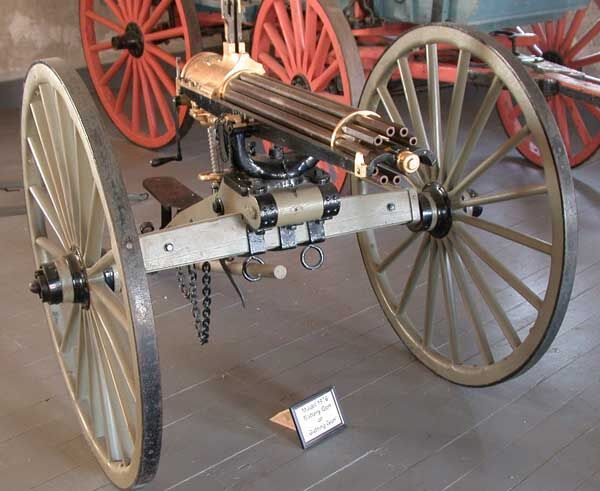 Invented by Richard Gatling, the Gatling gun is considered a forerunner to the modern automatic firearm and was one of the first effective rapid fire weapons. Early versions fired up to 250 rounds per minute and required a crew of at least 4. Its inventor, Richard Gatling, wrote that he invented them to decrease the size of armies and therefor the number of soldiers killed by disease, as illness and infection killed far more soldiers than bullets. Unfortunately he misjudged the callousness of government and, if anything, his invention and its spinoffs (such as machine guns) made war far worse. In the Civil War Gatling guns were not used widely, mostly in the east during the long siege of Petersburg and Richmond by Union forces, and also mounted on gunboats. In fact, in spite of many firearm advances such as breach loading rifles, the Federal government was slow to embrace major advances. There were some interesting reasons for this we will be getting into when we look at infantry and cavalry firearms. The first Gatling guns were mounted on naval vessels, and the first sold to the army were purchased by Union General Benjamin Butler and the Army of the James. The Gatling gun was not officially adopted by the US army until after the war in 1866 and the hand crank version was used until 1911. And now back to zombies. .jpg) .jpg) These undead are runners, though in-engine they seem to go in slow motion a lot. .jpg) Just to show off the trail of (un)dead from the Gatling guns .jpg) .jpg) Confederate Undead have a very strong intimidation factor. Basically even if there are only a dozen if they get into hand to hand they will rout the unit they're attacking. Those muskets also fire, though they only have 2 or 3 shots as far as I can tell. .jpg) So while that one unit takes out the Gatling gunners, the other assaults the infantry. Here are the Yankees firing away at the approaching gray tide. .jpg) That's 3 Union flags there. 279 Undead Confederates against 900 living Unionists. .jpg) .jpg) Guess you could call them union busters? .jpg) On the other side after taking out the gunners, our other mini horde is attacking a lone regiment. .jpg) Morbid as it is to say the death animations are pretty good. I especially like the touch of bullets kicking up sprays of dirt. .jpg) .jpg) .jpg) .jpg) So there it is, the game has zombie mode. It's only Confederate for now, I'd assume for the pun value. Once campaign mode is done I would love to see a version set after the war where the Federal government has to supress a mass zombie uprising across historic battlefields. You could play as either the government in struggling to amass enough force to stem the undead tide, or the zombies as you exact revenge by eating the country alive. know it would be a lot of work but it could be done very well. Here's a parting shot. .jpg) This was just a little mini update I thought was fun. I have a lot of work, school, and volunteer commitments during the weekdays so large updates are realistically only going to be posted on weekends. In the meantime I'll try to do little things like this, either informative or fun. Hopefully the pace works for everyone reading.
|
|
|
|
Heh. The South will rise. Does this mod or LP have anything for  ? ?
|
|
|
|
I can try to bumrush through to Georgia when I do Union campaign mode to recreate Sherman's march to the sea. The problems are that it doesn't seem possible to burn towns down yet and there is an automatic crash right around turn 30. I'll try to work around it, or they may release another update by the time we get to that anyway. I am planning to work in a couple different games as we progress through the war, but I can't think of one that truly models Grant and Sherman's concept of total war. Maybe I'll grab and do a mini update with This War of Mine as that seems to come closest. I'm definitely planning to do major write ups of Sherman and Grant.
|
|
|
|
Thomas Jonathon Jackson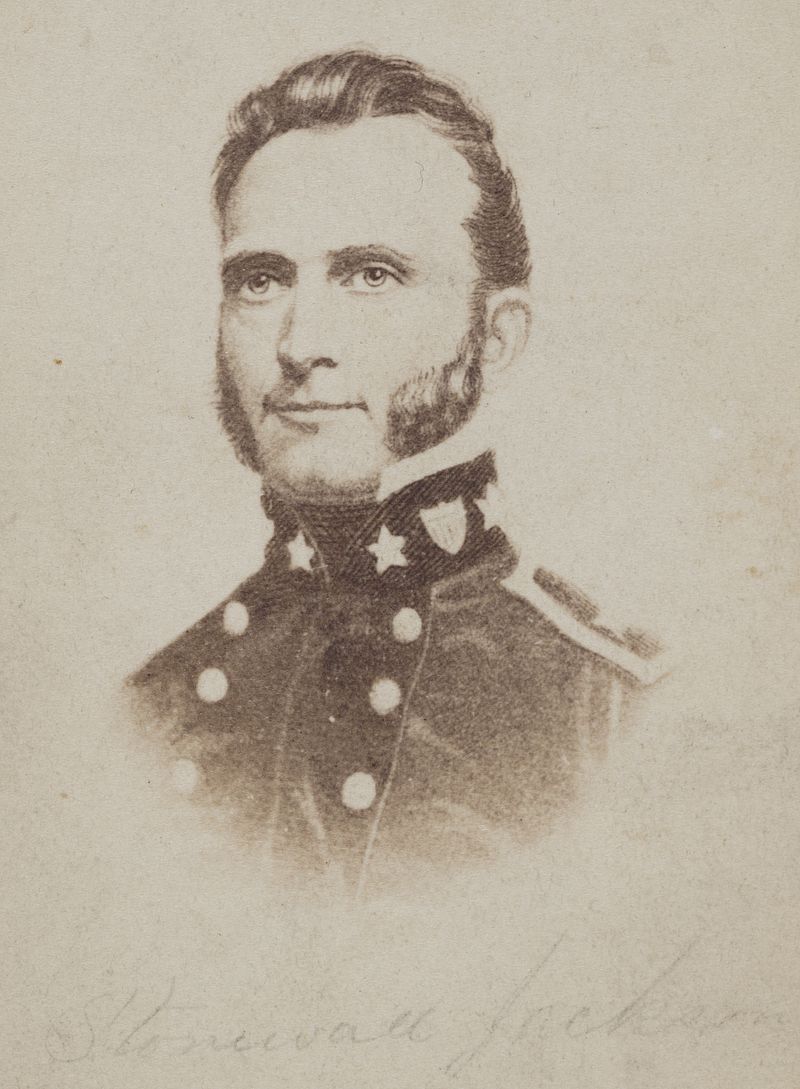 A young, hipster Stonewall It's a little ironic that the man widely regarded as America's greatest offensive general earned the nickname "Stonewall". In his short lifespan, Jackson rose from orphaned child to legendary soldier. He was abused, insulted, scoffed at, admired, and finally worshiped. While his mannerisms were odd enough that some today believe he had Asperger syndrome, he earned his contemporaries admiration through hard work and quiet brilliance in anything he applied himself to. His curriculum at VMI is still being taught today. Jackson made it to west point in 1843 in spite of an abusive, difficult childhood. Looking at class lists in his years is like a who's who of great civil war leaders. Ulysses S Grant (actual name Hiram Ulysses Grant), George Brinton McClellan, George Pickett, Ambrose Powell Hill, and recent graduates such as the class of 40's William Tecumpseh Sherman and George Thomas. Jackson would graduate 16th in his class due in part to a lack of formal education as a child, and many of his classmates believed that he might have graduated first given another year. As it happened George McClellan graduated second in that class. Already a hero from his conduct in the Mexican-American war, Jackson took a teaching position at the Virginia Military Institute and was there for the outbreak of the Civil War. He assembled several Virginia regiments at Harper's Ferry and became known as an absolutely relentless disciplinarian. He would see his first action of the Civil War at the first battle of Bull Run, or Manassas Junction as it was known in the south. .jpg) Here is the in game Stonewall brigade. The real stonewall brigade was made up of 5 regiments drawn from the Shenandoah Valley in Virginia. It was a renowned fighting unit that saw action in every major engagement until its destruction at Spotsylvania Courthouse in 1864. Of nearly 6,000 men who fought with the brigade during the war, only a single regiment of 219 remained to surrender at Appomattox. In the above image they are formed into maneuver columns, used for marching along roads and across fields as they were more flexible and easier to maintain than a battle line. One of the most important pieces drilled into soldiers of the day was the maneuver from columns of four into firing lines of two deep. After three to six months of drill a man could perform this drill with his eyes closed, a necessity on a battlefield where they might be blinded by smoke or fear. .jpg) Stonewall Jackson, at this point his most popular nickname being Tom fool for some of his mannerisms. Jackson was an eccentric. He was said to hold his left arm in the air for long periods of time to "balance the humors in his body". He loved any fruit and was said to be particularly fond of lemons, though his staff never mentioned any particular love of them and reported he simply ate whatever citrus was at hand. He suffered from what he viewed as dyspepsia, general indigestion, and attempted to treat it through citrus and mineral baths among other things. His attitude on slavery is very open to interpretation. On the one hand he was deeply religious and seemed to follow the view of the time that the bible condoned slavery, and he himself owned many slaves. At the same time he provided education to African Americans in spite of laws against this and led weekly sunday school classes for the local black population, and was beloved among them at the outbreak of war. Here is a wikipedia section regarding Jackson's 6 slaves: "Jackson's family owned six slaves in the late 1850s. Three (Hetty, Cyrus, and George, a mother and two teenage sons) were received as a wedding present. Another, Albert, requested that Jackson purchase him and allow him to work for his freedom; he was employed as a waiter in one of the Lexington hotels and Jackson rented him to VMI. Amy also requested that Jackson purchase her from a public slave auction and she served the family as a cook and housekeeper. The sixth, Emma, was a four-year-old orphan with a learning disability, accepted by Jackson from an aged widow and presented to his second wife, Mary Anna, as a welcome-home gift." Personally I don't feel any of this makes up for failing to see the inherent moral problems in owning another human being. Jackson was as good a master as any slave could hope to have, but that simple phrase shows just how little power slaves had over the course of their lives. Forgive me for saying this, but calling someone a kind slaveowner is like saying someone is a gentle rapist. However it is done, it is still abhorrent and assumes ownership of a person's body, of their agency and their dignity, no matter what Clarence Thomas says And I will get off my soapbox. I apologize, but seeing some of the edits to history books and the slave apologist historians go on about how well taken care of slaves were and how they got such first class accommodations and healthcare just pisses me off. It especially pisses me off that this crap is being taught to children now. How is it that 150 years after the war ended we still can't agree that slavery is bad and just move on? Alright, now I'll get off my soapbox. .jpg) This is the reason this update has taken so drat long. The makers of this mod were good enough to include several historical maps, including Manassas Junction. This here is the Henry Hill house, where Jackson made his famous stand. Unfortunately the AI doesn't quite know how to handle river fords, bridges, and the more realistic terrain of these maps and struggled. It took about ten tries, each a half hour or more, to get a full take that didn't crash or feature serious bugginess. However it is a great looking map. The maps are intended for multiplayer and I don't know anyone playing this mod. Historically, both armies at First Manassas had the plan of weakening their right flanks and attacking the opponent's left, crossing the Bull Run River at different points to do so. Had everything gone according to plan for both sides the two armies would have simply pirouetted around each other, both attacking the opposite flank of the other. It did not work out that way, with McDowell's Union army being plagued by poor coordination and untrained brigades moving slowly. Nevertheless early success went to the Union, driving back the equally unprepared Confederates and causing them to call off their own attack. The rich and famous of Washington had followed the army down in carriages, packing lunch so they could picnic and watch the battle. At this point it seemed their expectations of a quick trouncing of the rebels would come to pass. Then the battle reached Henry Hill. .jpg) So here is a close up of the bridge from the last picture. The bridge seems to be aesthetic, and troops crossing the river wade below it. I chose militia to reflect the lack of training and preparation of both side's forces for this battle. You can see the lack of adequate uniforms and material, which would soon change. .jpg) Confederate deployment of two brigades. In the foreground are three militia regiments to represent General Barnard Elliot Bee's brigade, while in the background are two Virginia Volunteer regiments and the Stonewall Brigade unit (which is currently capped at 1 per battle) to represent Jackson's brigade. Historically Bee was engaged to the front of Jackson, who held a line at the Henry Hill house. Because this map's scaling doesn't quite work for this Bee is going to hold the house and Jackson the hill behind. I also placed a battery of Napoleons under an AI commander because this is a 4 player map. The most impact they have on this battle is blowing up the house and shooting up one of Bee's regiments. Assholes. .jpg) .jpg) .jpg) It begins. Two federal regiments crossed the Bull Run and have engaged Bee's brigade. 4 more regiments are standing in line on the other side of the River. .jpg) Birds eye view of the current engagement. You can see Jackson's brigade off to the rear of the fighting. The Federals are in a slightly awkward firing line. .jpg) Union soldiers on the other side of the river begin marching to support. As an aside, I figured out there's an option to disable those giant flags that were in the first update. I prefer this look but let me know if the big flags were more helpful. .jpg) Jackson watching Bee get fully involved. .jpg) Just to show the most impact those Napoleons had on the field. For some reason the gunners really hated that house and the hill. I think they were trying to hit the reserves on the plain across the river but shell trajectories need a little tweeking still. .jpg) They continue to pour more troops in even as the advance guard gets driven back across the Bull Run. .jpg) A shot of Bee's brigade watching the oncoming federals as they form up. .jpg) This time they are coming on in force. Bee's men are starting to give back, as you can see the Federals overrunning ground covered in the fallen. .jpg) .jpg) .jpg) There's a fierce melee in which one of Bee's regiments drives off two federal regiments. They are frankly doing too well at this point, I had hoped they would be breaking now. Historically Bee's brigade gave a good accounting of themselves but suffered from lack of discipline, falling apart as the federals charged. Their stand certainly wasn't this determined. .jpg) .jpg) They finally start to break, leaving only one regiment standing on the ridge. .jpg) .jpg) They fight bravely and are finally driven back. It is at this point in the battle that General Bee is said to have turned on his horse and yelled "There is Jackson, standing like a stone wall! Let us determine to die here and we will conquer, rally to the Virginians!" Exactly what he said and what he meant are the subject of some debate. The controversy is over whether Bee was expressing admiration and encouraging his men to rally behind the brave Virginians, or if he was frustrated with Jackson not moving up to relieve his men ("there he is standing like a stone wall") and ordering his own brigade to fall back "to the Virginians". Personally I tend to think it was the latter, but it could never be determined because he was killed almost immediately after saying it. And that's how Tom Fool became Stonewall Jackson, and his brigade the Stonewall Brigade. .jpg) Speaking of, here they are arrayed in a firing line. .jpg) .jpg) And the Stonewall Brigade engages the enemy. During the battle Jackson was holding his left hand up, as explained before, to help balance the fluid in his body and keep his intestines straight. He was shot around the middle finger but refused to amputate after the battle. It was the discipline of Jackson's brigade more than anything else that carried Henry House and turned the tide at Manassas. Their ability to stand and deliver disciplined volleys while Bee's brigade disintegrated and the federals came storming up at them shocked their opponents. .jpg) .jpg) .jpg) It was at this point Jackson ordered his men to "yell like furies and give them the bayonet!" As legend has it this order and the charge that followed signaled the birth of the rebel yell. furies, not furries. .jpg) Here's a video of Henry House from a loving awful movie. Seriously that acting is so terrible. It's unfortunate because Gods and Generals wasn't that bad of a book but the movie is just garbage. Still, it has most of the important quotations and gives a decent idea of how things went on that front. So the story of First Manassas was that of an arrogant army that got its teeth stomped in by the brave sons of the south. Hopefully I've showed that things were a touch more nuanced than that (though not by much). Both armies were hideously unprepared for the shock of combat, both led by professionals who perhaps expected more of their men than barely trained militia were able to give, and both expecting the battle to be an easy and bloodless affair. Both were quite shocked by the reality, but the Confederates held a few distinct advantages. The first and foremost was that they were on the defense. It is much easier to wait for an enemy who has to march across rivers, hills, and forests to reach you. Even though armies at that point weren't digging in because it was "unmanly" simply not having to march towards the enemy was much easier on morale. Second was leadership, an advantage the south would hold for the first several years of war. Many professional army soldiers sided with their homes in the south and were rewarded with high ranking commissions. Pierre Beauregard and Joe Johnston, the Southern Generals at Manassas, were both professionals in the US army prior to the war. By contrast most of the remnants of the professional army were assigned to the west or to California, where with a few notable exceptions they would sit unused by the north. For the first several years many of the leadership positions in the Federal volunteer armies were held by political appointees (of which Ulysses S Grant was one). The biggest difference was made by Thomas Jackson's ability to marshal, discipline, and inspire the men under him to stand fast and charge into the teeth of a superior enemy force. While the first two advantages were significant, until Henry House the federals' superior numbers were largely winning the day. Jackson's countercharge sent them back on their heels and, though he suffered the highest number of casualties, created the greatest impact along the entire line. I think it's fair to say that without Stonewall Jackson and his brigade, First Manassas may well have been a Union victory. He would go on to cement his legend as a soldier by driving off 3 superior armies in the brilliant valley campaign, then serve as Robert E. Lee's right hand through multiple major engagements. He would hold Pope for a whole day at Second Manassas, take Harper's Ferry and save Lee's army at Antietam (Sharpsburg), fend off Burnside at Fredricksburg, and in what some call his greatest feat of military coordination and maneuver, utterly crush Hooker's flank at Chancellorsville (where he was unfortunately shot by his own men and died of complications 8 days later). Jackson was the south's most brilliant and successful soldier, and his men were the best this country had to offer. His ability to move men over tremendous distance in absolutely unrealistic speeds earned his Army of the Valley the nickname "foot cavalry". His accomplishments and genius on the battlefield and campaign map gave the southern cause hope for years where so many other fronts gave them defeat and setbacks. So for all those reasons, gently caress him, but damnit if I don't respect the man. 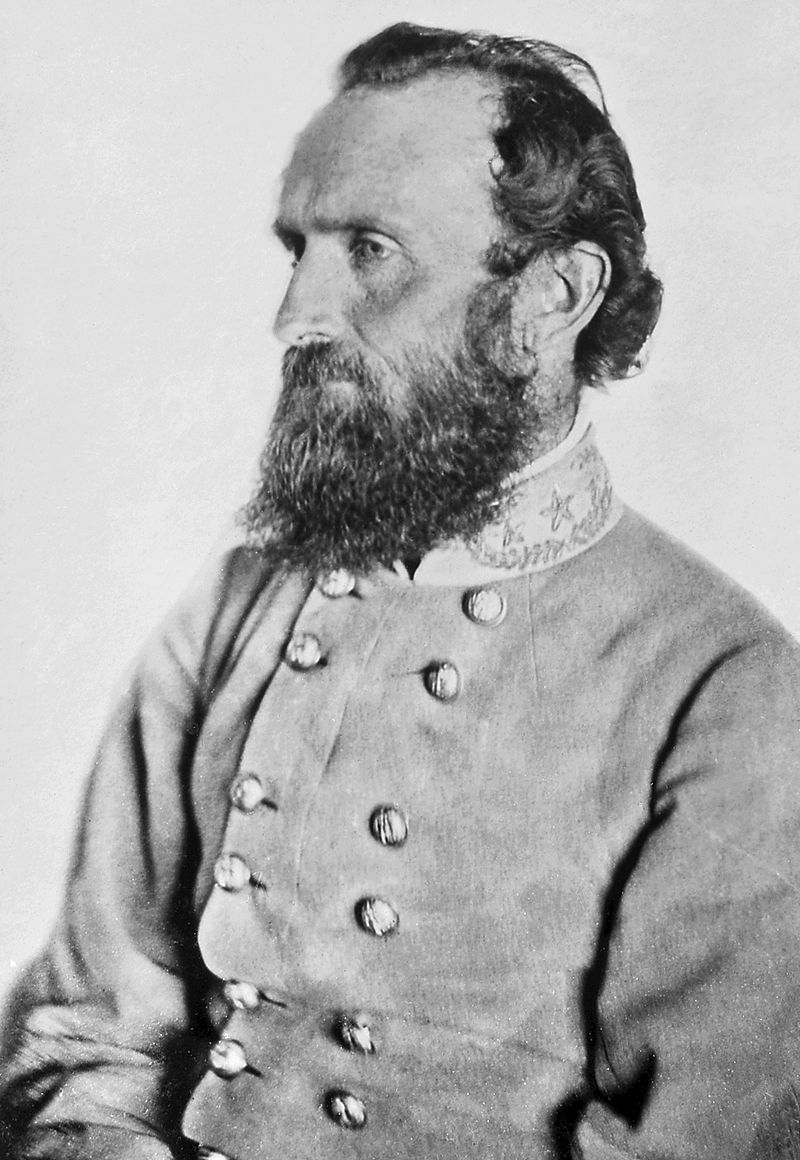 "Let us cross over the river, and rest under the shade of the trees" - Thomas "Stonewall" Jackson's final words. This update took a while because of the aforementioned reasons, and also because I really wanted to do Jackson justice and so ran into a little writer's block. He was an absolutely fascinating man who we are still learning from, and was a military prodigy. Hopefully I was able to convey this as well as some of the conflicting narratives about the man that are still debated. This is far from the last time we'll be seeing him in this LP. Edit: It's actually going to be a while now before the next major update because it's finals time (2 one hour groups, a research paper, a couple other papers, and a final this weekend and next) and my wife's birthday is coming up. I do have a plan I hope you will all find fun and interesting to fill in the time though. Cuveball Sliders fucked around with this message at 03:45 on Jul 22, 2015 |
|
|
|
On Confederate Zombies, when I was younger I saw a Civil War movie with Zombies that I remember being really good. Looked it up, and I remember the title being Killing Box, but apparently it's also known as Ghost Brigade or Grey Knight. It's not a schlock horror film really, it comes off as a really good indy film and has a surprisingly good cast. Worth a watch. Some interesting things on Bull Run: Jackson was under Johnston's command (Army of the Valley I believe). Johnston was in Winchester, and the movement of his troops via rail to intervene was one of the first mass movements of troops via rails. Also at this time, troops weren't wearing grey/blue. It was a mishmash of colors and one of the more infamous moments of the battle were caused by this. Two guns sent to the end of the Line by Griffin to enfilade the Confederate line. These guns were captured by the 33rd Virginia which was wearing blue uniforms, as the guns didn't realize they were Confederates until the last moment. These guns were turned on the Union lines during Stonewall's charge.
|
|
|
|
Have to say I'm enjoying the history lesson. This seems like a decent context to teach it in. Well, zombies aside, at any rate.
|
|
|
|
Seeing all of this makes me wish that Scourge of war was more competitively priced, while there are now plenty of mods for it it just sucks that its so drat expensive and people have to go to ETW mods to get their fix. Also good history lessons.
|
|
|
|
Letters from the Civil War So here is a mini-update where I will share letters from theatres across the country. They are written to sweethearts, friends, and family and hopefully will serve as a genuine introduction to the people who fought the war. We'll start with one of my favorites, a letter from a Union private besieging Charleston to his cousin. I love it because it is this great combination of teenage humor and jaded soldier. It's a start illustration of the fact that most of the men who fought in this war were younger than 20. Throughout history, old men wage wars that young men fight. quote:Morris Island, S.C.
|
|
|
|
Crowsbeak posted:Seeing all of this makes me wish that Scourge of war was more competitively priced, while there are now plenty of mods for it it just sucks that its so drat expensive and people have to go to ETW mods to get their fix. Also good history lessons. I'm going to show off some of Scourge of War when we get to Gettysburg, but I haven't picked up Pipe Creek or Antietam due to price. My honest opinion of it is that it's a great game that's really hard to enjoy. School semester is almost done. Unfortunately the partisan update I was hoping for is going to have to follow a different format than I was hoping for because the game I wanted to use (Mosby's Confederacy) doesn't play nicely with Windows 8 and it isn't worth figuring out. I may actually just run a cavalry scenario in Scourge of War or stick with Empire for it. Hopefully it will be mostly set for writing out by Sunday. Needed to take a break from writing after last weekend.
|
|
|
|
Here is a letter home from a soldier in the "Rockbridge Rifles" regiment, a Virginia unit organized in Rockbridge County which contains the city of Lexington. The Rockbridge Rifles were assembled in 1859 as a militia unit in response to John Brown's attempted uprising and its elements fought in almost every engagement in Virginia from Bull Run to Appomattox, where it surrendered and was dissembled. quote:
It is fun to read the exaggeration of casualty counts and total enemy numbers. In truth about 32,000 Union and 29,000 Confederates were engaged at Manassas Junction, and each side lost roughly 2,000 men. This tendency to exaggerate was common throughout the war and is especially notable in the correspondence and official reports of generals. For example General Grant sent a message to Lincoln after Cold Harbor, where 7,000 Union fell to very few Confederates, that his casualties were light and about even on both sides. McClellan is also famous for vastly overestimating enemy numbers and this would doom him on every field he led an army. It's human nature to believe you're outnumbered and horribly outmatched in such a terrifying situation, when every moment feels like you're just trying to survive in place. I've heard it described as protagonist syndrome, where everyone believes that their struggle is the center of everything that matters. The end of the letter about bringing the dead and wounded home is sobering, and reminds me of just how young and naive many of the soldiers were at this point of the war. Manassas was the bloodiest single battle in American history to that point and turned out to be one of the least bloody major battles of the war. A year later after 2nd Manassas many men would simply be buried in shallow graves with perhaps a single cross to mark them or, tragically, left hidden and exposed to the elements. We can get into burial practices more when we learn about medical practice and surgery, one of my favorite subjects. Edit: The Rockbridge Rifles battleflag 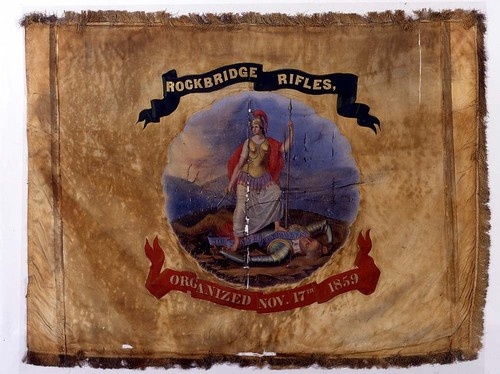
Cuveball Sliders fucked around with this message at 02:02 on Jul 30, 2015 |
|
|
|

|
| # ? Apr 19, 2024 15:24 |
|
Glazius posted:Have to say I'm enjoying the history lesson. This seems like a decent context to teach it in. Well, zombies aside, at any rate. Hate to doublepost but I wanted to say thank you. I really enjoy researching and writing these updates and the discussion this thread has created.
|
|
|













